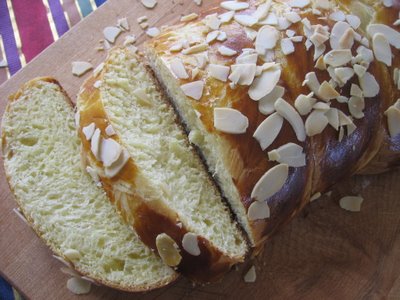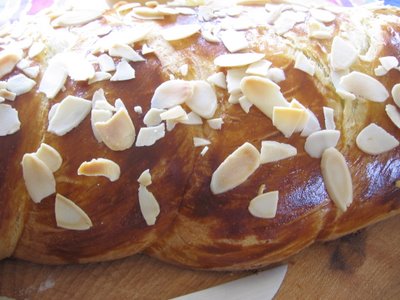Easter Bread with a Twist
 This fragrant and lightly sweetened loaf was introduced to Turkish cuisine by Christian bakers, and has become a patisserie staple since then. What makes this version different from other easter bread recipes is the use of two unusual ingredients: mastic and mahleb. Call it Easter Braid or Paskalya Coregi as we do in Turkey, this is a sweet bread you'll want to bake year-round, not just for Easter. It is as much a delight to prepare as to eat.
This fragrant and lightly sweetened loaf was introduced to Turkish cuisine by Christian bakers, and has become a patisserie staple since then. What makes this version different from other easter bread recipes is the use of two unusual ingredients: mastic and mahleb. Call it Easter Braid or Paskalya Coregi as we do in Turkey, this is a sweet bread you'll want to bake year-round, not just for Easter. It is as much a delight to prepare as to eat.The recipe was adapted from A. E. Algar's Classical Turkish Cooking.

- 2 1/2 tsp active dry yeast
- 1/4 c warm milk
- 1/4 c flour
- 1/8 tsp sugar
- 1 tsp mastic, crushed lightly
- 1 1/2 tsp mahleb (should be pulverized)
- 1/2 c milk
- 2 1/2 c flour
- 2 eggs and 1 egg yolk, lightly beaten
- 1/2 c sugar
- 4 oz unsalted softened butter
- 1 egg yolk mixed with 2 tsp cream or milk for the glaze
- Slivered almonds for decoration (optional)
Meanwhile, infuse the remaining milk (1/2 c) with mastic wrapped in a small cheesecloth bundle. You should simmer it 20 minutes. By the end of this time, you should have about 1/4 c of mastic infused milk left. If more, boil away; if less, add more milk to make 1/4 cup. Cool.
 Add the softened butter, eggs plus egg yolk, mahleb, sugar, milk and the yeast mixture to the flour. Mix the ingredients with your fingertips first and then work it into a dough. As this will be quite soft and sticky, you'd better resort to the help of your mixer at this point. Knead it for 5 minutes, preferably with the dough hook. Then knead by hand for at least another 5 minutes. If you do not have a mixer, you need to knead by hand for at least 15 minutes. At any rate, at the end of the kneading period, the dough has to be smooth and springy. Put it in a greased bowl, cover loosely with plastic wrap and let rise in a warm place for 3 hours or until doubled in volume.
Add the softened butter, eggs plus egg yolk, mahleb, sugar, milk and the yeast mixture to the flour. Mix the ingredients with your fingertips first and then work it into a dough. As this will be quite soft and sticky, you'd better resort to the help of your mixer at this point. Knead it for 5 minutes, preferably with the dough hook. Then knead by hand for at least another 5 minutes. If you do not have a mixer, you need to knead by hand for at least 15 minutes. At any rate, at the end of the kneading period, the dough has to be smooth and springy. Put it in a greased bowl, cover loosely with plastic wrap and let rise in a warm place for 3 hours or until doubled in volume. Punch down the dough, knead it lightly and shape it into a log. Divide the log into 3 equal pieces; shape each into a ball. Cover the balls with a towel and let rest for 20 minutes or so. Roll the balls into 20" ropes. Take care that the ropes are plumper in the middle than at the ends. Cover again and let rest another 20 minutes. Take the ropes to a lightly greased baking tray and braid them. (I found it easier to braid starting from the middle.) When you come to the ends, tighten the braid, pinch and tuck under. Now put the tray to a warm place and let rise until doubled. (1 to 3 hours)
Punch down the dough, knead it lightly and shape it into a log. Divide the log into 3 equal pieces; shape each into a ball. Cover the balls with a towel and let rest for 20 minutes or so. Roll the balls into 20" ropes. Take care that the ropes are plumper in the middle than at the ends. Cover again and let rest another 20 minutes. Take the ropes to a lightly greased baking tray and braid them. (I found it easier to braid starting from the middle.) When you come to the ends, tighten the braid, pinch and tuck under. Now put the tray to a warm place and let rise until doubled. (1 to 3 hours) Preheat the oven to 350F. Glaze the braid with the egg yolk and cream mixture. Wait a couple of minutes and give it another glaze. Sprinkle with the almonds. Bake the bread 25 to 30 minutes. You can test the thickest part with a skewer for doneness; it should come out clean. This is excellent when it is freshly baked, but it will also keep well if it is nicely wrapped after it has cooled down. Try it lightly toasted, too.
Preheat the oven to 350F. Glaze the braid with the egg yolk and cream mixture. Wait a couple of minutes and give it another glaze. Sprinkle with the almonds. Bake the bread 25 to 30 minutes. You can test the thickest part with a skewer for doneness; it should come out clean. This is excellent when it is freshly baked, but it will also keep well if it is nicely wrapped after it has cooled down. Try it lightly toasted, too.


















<< Home